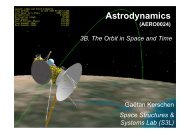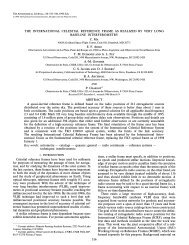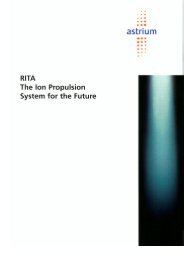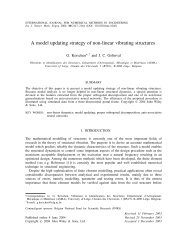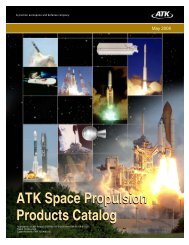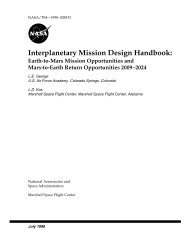CASSINI MANEUVER EXPERIENCE: FINISHING INNER CRUISE
CASSINI MANEUVER EXPERIENCE: FINISHING INNER CRUISE
CASSINI MANEUVER EXPERIENCE: FINISHING INNER CRUISE
You also want an ePaper? Increase the reach of your titles
YUMPU automatically turns print PDFs into web optimized ePapers that Google loves.
and the Earth swingby. The Jupiter swingby is about one-third maneuvers.[3] . The final sequence of bias-removal aimpoints<br />
of way into the subsequent 5 years. There are many activities for the Earth swingby are depicted graphically in Figure 2 and<br />
to be accomplished within this time, including the execution listed in Table 111.<br />
of up to 21 TCMs.<br />
The previous paper [2] concluded with mention of a<br />
trajectory redesign. That redesign obviated two maneuvers by<br />
accepting the current trajectory best estimate as the start of a<br />
new reference trajectory and redesigning the downstream<br />
events and maneuver targets to accommodate it. [3] After the<br />
large Deep Space Maneuver (DSM), detailed below, another<br />
trajectory redesign was performed. [4] Again, the current best<br />
estimate became the reference and all downstream events and<br />
maneuver targets changed. Only the results of this most recent<br />
redesign are reported.<br />
The previous paper also reported on the emerging design<br />
of TCM-St, a test maneuver. The purpose of TCM-St was to<br />
characterize the propulsion system by simulating conditions<br />
that would be seen later in cruise. However, after some<br />
further study these conditions proved to be more difficult to<br />
attain that expected. One particular complication was in the<br />
strategy for heating the spacecraft’s propulsion system to<br />
reflect conditions somewhat closer to the sun; in fact, a<br />
suitable strategy for this heating was not found. The so-called<br />
test maneuver was cancelled.<br />
A total of twenty-one maneuvers enter into the<br />
navigation strategy for 97 VVEJGA. The first two of these<br />
maneuvers were reported in the previous paper along with the<br />
cancellation of the third and fourth maneuvers. Several of the<br />
remaining TCMs during cruise and the final approach to<br />
Saturn are deterministic, viz. have a non-zero mean AV. For<br />
the most part, these deterministic components were designed<br />
in support of the Earth Swingby Plan [5]; they remove, in<br />
piecemeal, a built-in trajectory bias of the Earth swingby<br />
aimpoint. The trajectory bias was implemented by specifying<br />
targets in Earth’s B-plane for the maneuver sequence from the<br />
TCM-9 to TCM-12<br />
In addition to biasing in the B-plane, the time-of-arrival<br />
for the Earth swingby was altered with each maneuver. The<br />
time-of-arrival targets were specified to reduce the AV cost of<br />
the. strategy. If a given bias-removal maneuver was not<br />
executed, both the B-plane aimpoint and the time-of-arrival<br />
would have been in error.<br />
The post-Venus-1 redesign turned the current best<br />
estimate of the trajectory into the reference trajectory. A study<br />
of how this redesign would affect the Venus-2 delivery<br />
dispersions prompted a reconsideration of the post-DSM/pre-<br />
Venus-2 trajectory segment for the Earth Swingby analysis.<br />
As a result, a bias was introduced into the Deep Space<br />
Maneuver (DSM) design which would be removed by TCM-7.<br />
TCM-6 and TCM-8 would remain unbiased clean-up<br />
2<br />
h<br />
E<br />
25<br />
Q)<br />
0<br />
C<br />
tlJ<br />
c<br />
v)<br />
.-<br />
n<br />
I<br />
i<br />
-2 1 O4 ...............,............... TCM-12<br />
Aimpoint<br />
7 A / !<br />
Aimpoint /<br />
-4 lo4 0 4 lo4 8 lo4<br />
BeT - Distance (km)<br />
Figure 2: Aimpoint Biasing Strategy for Earth (Earth<br />
B-Plane)<br />
The post-DSM redesign maintained the pre-Venus bias.<br />
However, this time the bias removal was split between TCM-6<br />
and TCM-7 in such a way that TCM-6 maintained the same<br />
Earth B-plane target as the DSM but the Earth TCA target<br />
changed, as listed in Table V. In this way, TCM-7 was small<br />
enough to be performed with the monopropellant system.<br />
TCM-8 remained an unbiased clean-up maneuver.[4]<br />
Maneuver Execution<br />
The Cassini’s Propulsion Module Subsystem (PMS)<br />
consists of a bipropellant element, the main engine, for large<br />
trajectory corrections and a monopropellant element, the<br />
Reaction Control Subsystem (RCS), for small trajectory<br />
corrections, attitude control functions,<br />
desaturation. [6]<br />
and reaction wheel<br />
The RCS is used for small maneuvers, viz. less than 1<br />
ds. The RCS consists of 4 hydrazine thruster clusters - a<br />
total of 8 primary and 8 backup thrusters. These small,<br />
monopropellant thrusters supply about 0.98 Newtons each<br />
when fully pressurized and an I,, of about 195 seconds. They<br />
are labeled in Figure 4. The thrusters may be grouped into<br />
two sets. The first set faces the *YsIc spacecraft directions; it<br />
is used to make balanced turns about the Z,, axis (roll turns).<br />
The other set faces the -Z,,, axis and is used to make



